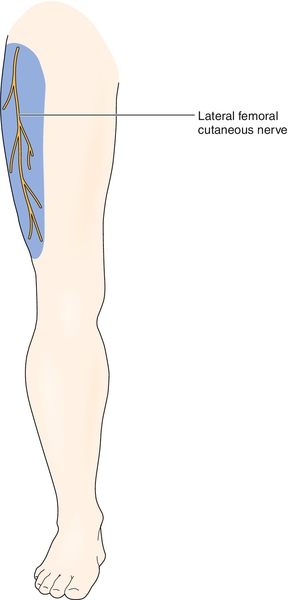CHAPTER 57
Lateral Femoral Cutaneous Neuropathy
Earl J. Craig, MD; Daniel M. Clinchot, MD
Definition
Lateral femoral cutaneous neuropathy, commonly called meralgia paresthetica, is the focal injury of the lateral femoral cutaneous nerve causing pain and sensory loss in the lateral thigh of the affected individual. The incidence of lateral femoral cutaneous neuropathy in the general population is 4.3 per 10,000 person-years. In addition, van Slobbe and colleagues [1] found that this neuropathy is more common in patients with carpal tunnel syndrome.
The lateral femoral cutaneous nerve is a pure sensory nerve that receives fibers from lumbar nerve roots L2-L3 (Fig. 57.1; see also Fig. 54.1). After forming, the nerve passes through the psoas major muscle and around the pelvic brim to the lateral edge of the inguinal ligament, where it passes out of the pelvis in a tunnel created by the inguinal ligament and the anterior superior iliac spine [2–4]. A number of anatomic variations have described the exit of the lateral femoral cutaneous nerve from the pelvis [5]. Approximately 25% of the population has an anomalous course of the lateral femoral cutaneous nerve out of the pelvis [6]. Approximately 12 cm below the anterior superior iliac spine, the nerve splits into anterior and posterior branches. The nerve provides cutaneous sensory innervation to the lateral thigh. The size of the area innervated varies among individuals.

The nerve may be injured as a result of a number of causes, as outlined in Table 57.1. Lateral femoral cutaneous neuropathy is more commonly seen in overweight individuals because of compression of the nerve (due to abdominal girth) when the thigh is flexed in a seated position.
Symptoms
Patients typically complain of lateral thigh pain and numbness. The numbness may be described as tingling or a decrease in sensation. The pain is often burning in quality but may be sharp, dull, or aching. The patient may also complain of an itching sensation. In some instances, there will be a precipitating event, such as a long car ride in which the patient was seated for a prolonged period, putting stress on the nerve. This is especially true in individuals who wear the seat belt snuggly. The patient should not complain of weakness in the lower extremities. The diagnosis requires a high index of suspicion by the evaluating clinician.
Physical Examination
Because the lateral femoral cutaneous nerve is purely sensory, the only finding typical of this condition is decreased sensation, which should be limited to an area of variable diameter in the lateral thigh. In adult men, the clinician may also see an area on the lateral thigh in which the hair has rubbed off. Palpation over the anterior superior iliac spine may exacerbate symptoms.
The physical examination is also used to exclude other possible causes of pain and weakness of the hip, thigh, and knee. A complete neuromuscular evaluation of the low back, the hips, and the entire lower extremities is needed. This examination should include inspection for asymmetry or atrophy, manual muscle testing, muscle stretch reflexes, and sensory testing for light touch and pinprick. In the case of lateral femoral cutaneous neuropathy, the clinician should not see muscle atrophy or asymmetry or weakness of lower extremities. Reflexes should remain intact, and sensory testing outside of the lateral thigh should reveal intact function.







